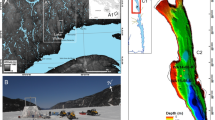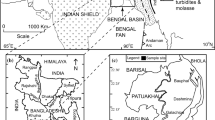Abstract
A freeze-drying technique for cutting thin-sections of soft sediments without disturbance is used to study several Lake Baikal sedimentary microstructures. Image analysis methodology is applied to selected thin-sections. This new technique provides quantification of the size, shape, orientation and packing of the objects forming the sedimentary structures. Sedimentary processes, which were previously poorly documented, have been identified, and others are better understood. Spheroidal lens-like pure aggregates of the diatom genus Synedra are found in hemipelagic sediments, providing a new insight into their traditional paleoecological interpretation. They are possibly related to a transportation mechanism from the littoral zone or to lacustrine snow. Laminae of Aulacoseira have also been recorded. Evidence of rapid sedimentation suggests they are due to massive algal blooms. The depositional mechanism that was suggested by other studies for explaining the laminations at the Buguldeika uplift is confirmed: the hemipelagic sedimentation is interrupted by terrigenous pulses due to discharge events. The sedimentation rate appears to be increasing during these pulses. Preliminary results from the Academician Ridge show stronger microbioturbation during cold periods. This observation strengthens the hypothesis of intense water circulation during colder times. Thin-section image analysis provides crucial information for deciphering lacustrine records and their regional and palaeoclimatic significance.
Similar content being viewed by others
Author information
Authors and Affiliations
Additional information
Received: 27 November 1998 / Accepted: 13 September 1999
Rights and permissions
About this article
Cite this article
Francus, P., Karabanov, E. A computer-assisted thin-section study of Lake Baikal sediments: a tool for understanding sedimentary processes and deciphering their climatic signal. Int Journ Earth Sciences 89, 260–267 (2000). https://doi.org/10.1007/s005319900064
Issue Date:
DOI: https://doi.org/10.1007/s005319900064




